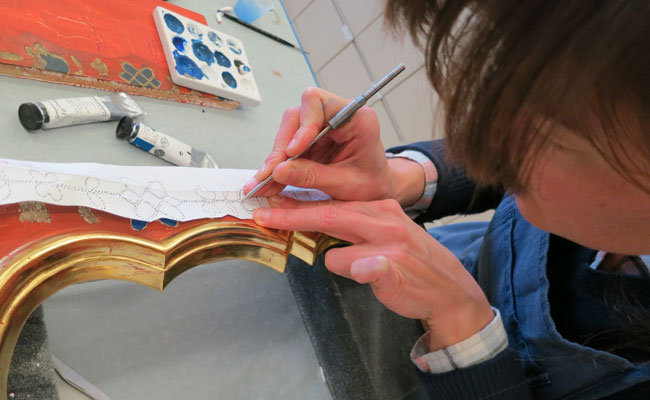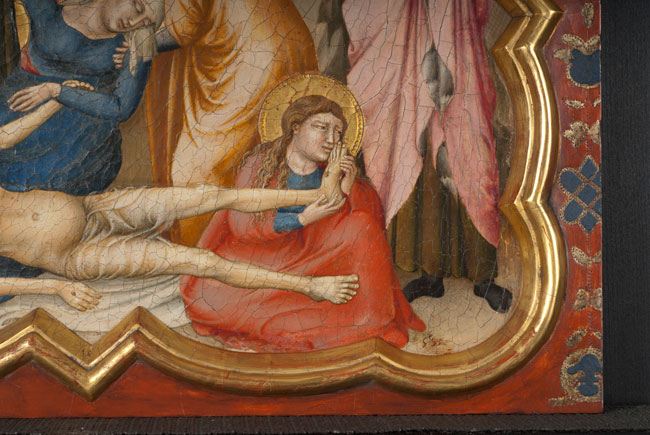The rectangular frame that had long housed the Master of the Fogg Pietà’s The Lamentation over the Dead Christ (c. 1330) was not original. As we recently reported, x-radiographs of the Lamentation indicated that the panel was part of a larger series of images and that underlying incision lines pointed to where the painting’s original quatrefoil molding, or engaged frame, was once fixed. This was consistent with what was found on the other “predella,” or base, panels. At some point in this painting’s history, the quatrefoil molding was cut away. The rectangular frame that replaced it exposed a compositional field much larger than the early Renaissance artist intended, and was historically anomalous.
In the 1930s, Fogg Museum conservator R. Arcadius Lyon inpainted the panel in places where the original frame would have been, using an innovative cross-hatching technique. He developed this method to make his integration apparent from up close but blend in when seen from a short distance. Stephan Wolohojian, the Landon and Lavinia Clay Curator, notes that the rectangular frame “gave the painting a more modern appearance, and certainly made the painting seem less Gothic.”
Re-creating a 14th-century frame with such an unusual shape is a complicated undertaking, one that requires specialists in both carving and gilding—and no small amount of creativity. When frame conservator Allison Jackson joined the Straus Center for Conservation and Technical Studies, the museums finally had assembled a team with all the expertise needed to re-create the Lamentation’s original frame.
Before work could begin, extensive planning and research was necessary. Jackson examined materials presented on a website for a collaborative study of the entire altarpiece. She and conservator Teri Hensick made digital images showing various framing solutions. Jackson traveled to London’s Courtauld Institute of Art to see the Lamentation’s companion panels from the altarpiece’s predella: Saint Lawrence, a panel that preserves the altarpiece’s only existing remnants of original frame; and A Bishop Saint, a panel that itself recently received a new frame, created by the National Gallery of London’s Isabella Kocum, who shared tips for artificially aging a surface to give it a 14th-century look.
Jackson, Wolohojian, and Hensick decided that the frame’s shape and decoration should be like Saint Lawrence’s existing frame remnant, with a floral punchwork pattern, paint, and silver gilding on the frame’s vertical sides. The conservation team produced detailed drawings on Mylar to determine the exact location of the frame’s position, and Jackson made many mock-ups to decide on the desired finish for the frame.
With mapping and testing complete, Jackson contracted master carver Phil Lowe of the Furniture Institute of Massachusetts to create the frame. He hand-carved the frame for the Lamentation from a single plank of wood, which allowed him to accommodate its uneven surface and irregularities.
Once the frame arrived at the museums, Jackson applied a gesso coating and used various techniques to match the panel’s existing crack network. She applied a red bole (a traditional material made of clay and rabbit skin glue over which gold leaf is applied) and gilded and burnished the inner molding. She transferred the floral design modeled after the Saint Lawrence’s decorative pattern to the outer molding, then gilded the pattern and painted the flower’s blue centers with egg tempera, adding aluminum oxide abrasive to imitate the coarsely ground Azurite that may have been used on Saint Lawrence. She applied layers of shellac to seal the water-soluble layers below. After additional cracking to the gilded molding, she toned or artificially aged the frame surface using more shellac and acrylic paint. Finally, she applied a coat of wax to the entire frame, and the Lamentation over the Dead Christ’s new frame was complete.
When visitors see this painting after our opening this November, they’ll likely be surprised to learn that the frame isn’t original. If you look closely in areas where the frame meets the panel, you can see some of Lyon’s unique cross-hatched retouching—a conscious decision made by the curators and conservators to retain this significant piece of art conservation history. “The frame’s reconstruction restores the energy of the painting’s composition,” said Wolohojian. “But it also preserves Lyon’s efforts beneath it, which is an important moment in conservation history.”
Work is ongoing to unlock other secrets related to the Master of the Fogg Pietà’s altarpiece. Wolohojian is coeditor of a forthcoming publication, funded by The Richard & Natalie Jacoff Foundation, and is a key figure in the continuing effort to map the altarpiece. With the spirit of international collaboration that has been demonstrated thus far, surely more of its mysteries will be solved in the coming years.






